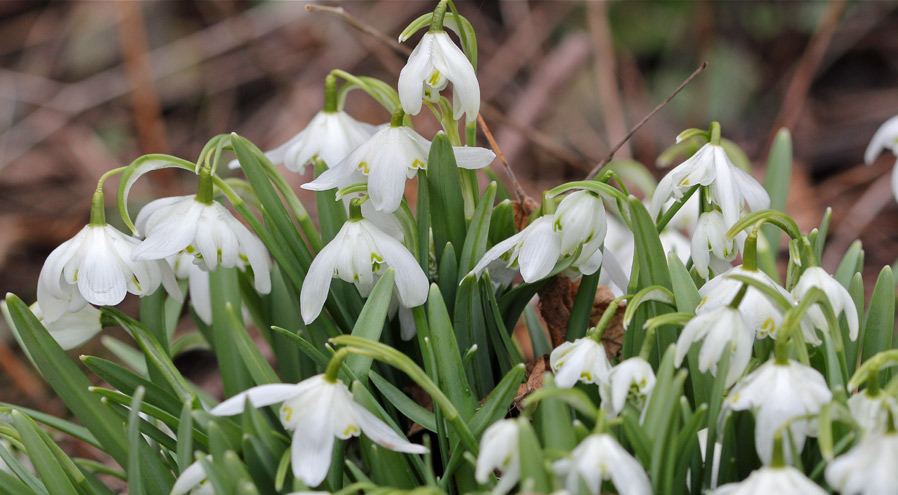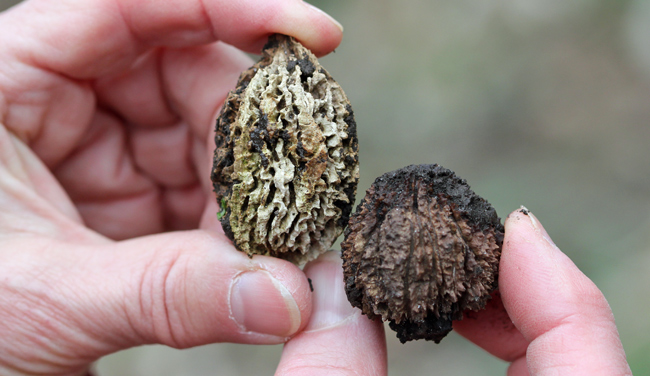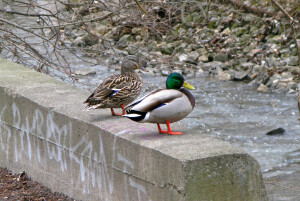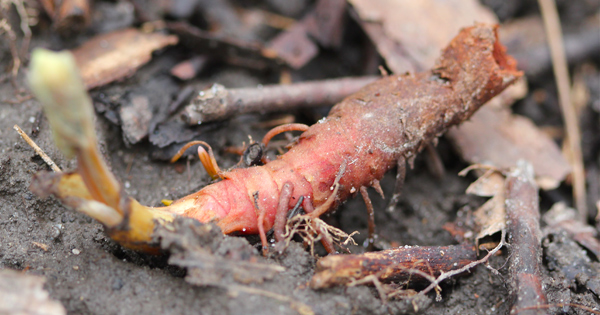Snowdrops (Galanthus nivalis), on a wooded hillside at Taylor Creek Park on Tuesday, April 5, 2011. © BCP 2011
Tuesday morning, 10 a.m. The morning is as grey as old, cold dishwater, and a bitter wind whips me as I wait at the Victoria Park subway station for the woman who is to be my guide on a walk in a nearby park. I hardly know Taylor Creek Park. I should, as it’s near home. And it is, after all, a creek that’s part of my watershed, the Don.
So when Melanie, a naturalist with the Toronto Field Naturalists group, invites me to go along on with her on a “pre-walk” — that is, a walk she takes before leading an entire group of TFN members through these urban woodlands on a spring wildflower hike — I am delighted to accept. Before her official walk, she needs to find out what verdure is up, and where.
It doesn’t feel much like a day to go in search of spring wildflowers. I am wearing my down coat. Coming back after three hours of slogging about in the soggy woods, Melanie confesses she’s wearing her long johns. Good move. April 5? It doesn’t feel much like global warming today.
But we set out anyway. Our first wildflower stop (after a quick look at a new wetland that’s was officially opened in 2009) is on a wooded south-facing hillside. At the top of the hill is a beautiful old Arts and Crafts-style mansion that was the former home of Dorothy Massey (part of the Massey Goulding Estate.) The 1920’s building is now owned by the City of Toronto, and is used by the Children’s Peace Theatre.
Mrs. Massey must have had a lovely spring garden. The snowdrops (Galanthus nivalis) at our feet no doubt escaped from cultivation; they are now naturalized on the hillside. The tiny white flowers peeking through the layers of fallen leaves are as welcome a spring sight as the first returning robin.
According to Wiki, the great Swedish physician and life scientist, Carl Linnaeus, gave these delicate flowers their scientific name in a paper published in 1753. The plant’s generic name, Galanthus, comes from the Greek gala (milk) and anthos (flower). The plant’s species name, nivalis, is Latin for “of the snow.” Did Linnaeus mean that the blooms were as white as snow? Or was he referring to the plant’s tendency to bloom as the snow is melting?
I don’t know. But I do know I was glad to see these tiny snowdrops as they were the only flowers we saw on our walk.
Melanie holds a butternut, left, and a black walnut, found on the slope near the snowdrops. © BCP 2011
On the same hillside, as I’m photographing the flowers, Melanie is digging about in the mouldering leaves. She finds one nut, then another. They’re the fruit of the enormous trees on this hill, butternut (Juglans cinerea) and black walnut (Juglans nigra). Perhaps they’ve been here since the time of the Masseys.
I am both surprised and delighted by her find. Concentrating on the flowers, I never would have seen the nuts that are almost completely buried in the duff. I wouldn’t have later looked up the trees, and found out how closely related they are. I didn’t know, for example, that another name for butternut is white walnut. Both are native to our area.
A little further on, we come to a swiftly moving section of the very full creek, which appears to be home to many pairs of mallard ducks (Anas platyrhynchos).
A pair of mallards take it easy by the creek. © BCP 2011
One pair in particular has made their accommodation to urban living. There’s probably lots to eat around the creek, but it’s so much less trouble to wait on the concrete ledge, waiting for a free lunch to walk by.
As soon as these two see us, they hop off their ledge and waddle over to us, looking for a handout. Lazy? Smart? Both?
Out of the woods and along the path, we encounter a patch of pussy willows in bloom. They don’t look like the ones I’m familiar with at the beach, perhaps because they’re younger.
Pussy willows (Salix discolor) are out in the valley. © BCP 2011
I don’t think they’re wild. It’s more likely they’ve been planted as part of a concerted effort in these valley lands to eradicate the invasive non-native vegetation and replace it with native species.
It’s out with the bad, in with the good. . .
Goodbye garlic mustard!
Arrivederci avens! Bon voyage, balsam of the Himalayas! (I still think you’re the pretty one, no matter what the others say.) Say hello to pussy willows (Salix discolor).
Our ramble in the blustery cold continues along the path, then we take a detour into the woods once again to look for bloodroot (Sanguineria canadensis.) No need for a Latin or Greek translation of this plant’s name.
Close-up of bloodroot at Taylor Creek Park. © BCP 2011
Bloodroot’s another plant I’m being introduced to. I have no idea where to look for it but Melanie does. And she finds some, too.
It’s just coming up on another south-facing slope, where the ground is just that much warmer and the growing things that emerge from the soil are just that much further ahead.
The bloodroot’s beautiful, delicate, white flowers are nowhere to be seen this morning, but the stems are pushing up through the dank earth, and the blood-red roots, obvious once you know what to look for, literally carpet the slope.
When cut open, the roots of this plant reveal a reddish sap that was used as by native populations as a dye and as an herbal preparation for sore throats and bronchial problems. Bloodroot is still used today as an anti-plaque agent in mouthwash, among other pharmaceutical uses.
I wonder what else is emerging along the woodland floor? If it would just warm up a few degrees, I might just get a glimpse of the bloodroot blossom in a few days.
© BCP 2011








no comments